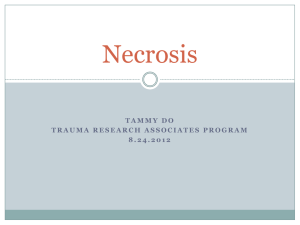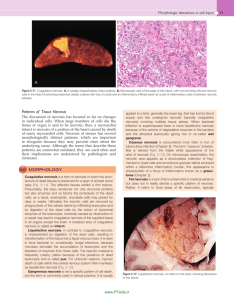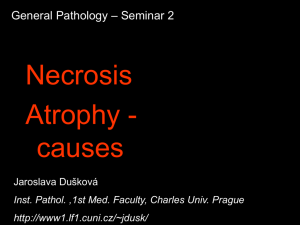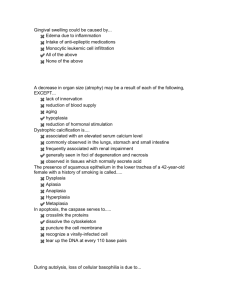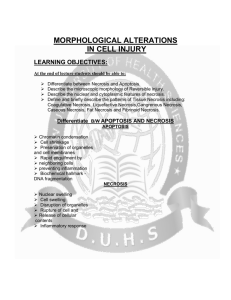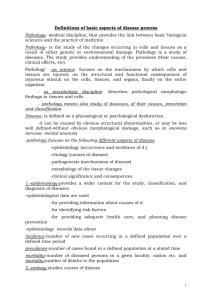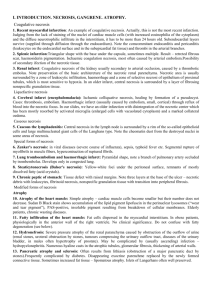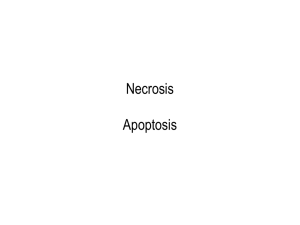Morphological alterations in Cell Injury and Necrosis
advertisement
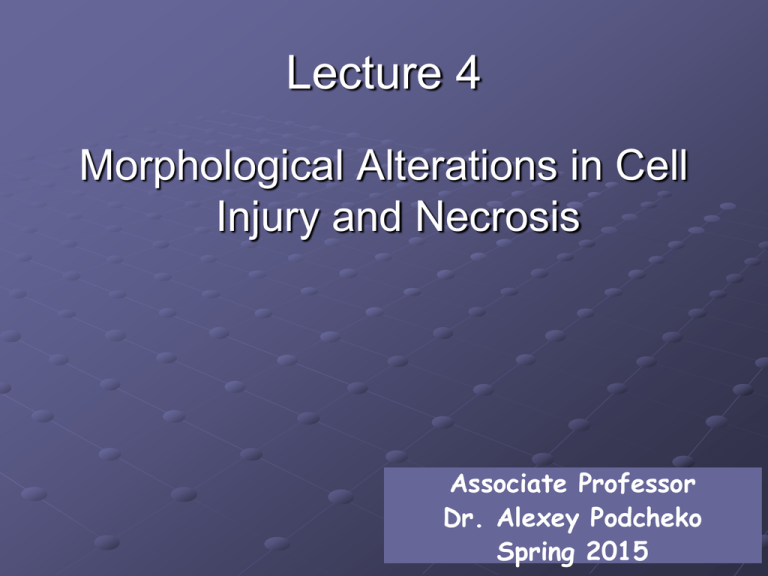
Lecture 4 Morphological Alterations in Cell Injury and Necrosis Associate Professor Dr. Alexey Podcheko Spring 2015 A routine H&E histologic section from an irregular white area within the anterior wall of the heart of a 54-year-old female who died secondary to ischemic heart disease reveals the myocytes to be replaced by diffuse red material. This material stains blue with a trichrome stain. Which one of the listed statements correctly describes this material? It is secreted by fibroblasts and has a high content of glycine and hydroxyproline It is secreted by endothelial cells and links macromolecules to integrins It is secreted by hepatocytes and is mainly responsible for intravascular oncotic pressure It is secreted by monocytes and contains a core protein that is linked to mucopolysaccharides INTENDED LEARNING OUTCOMES 1. To know at least 4 morphological signs of reversible injury 2. To know 3 morphological features of necrosis 3. List 6 morphologic patterns of necrosis with clinical examples Stages of the cellular response to stress and injurious stimuli Common Mechanisms Leading to Cell Injury and Death 1 2 3 4 5 What are the signs of REVERSIBLE and IRREVERSIBLE injury? Sequential development of biochemical and morphologic changes in cell injury •There is a time lag between the stress and the morphologic changes of cell injury or death •Light microscopy changes of cell death visible only 4-12 hours after total ischemia List of Reversible Injury Associated Morphologic Changes 1. Acute swelling of the cell and cellular organelles (mitochondria, nucleus) a. Formation of membrane blebs b. Detachment of polyribosomes from dilated ER c. Clumping of nuclear chromatin (desegregation) 2. Fatty changes (lipid vacuoles) 3. Loss of Glycogen Acute swelling of the cell Acute swelling is the result of failure of energy-dependent ion pumps in the plasma membrane Gross View of Cellular Swelling (Edema) at the level of whole organ Pallor, turgor and increased weight Microscopic changes induced by cellular edema (swelling) 1. Appearance of clear vacuoles (distended ER)- vacuolar degeneration 2. Increased eosinophilic staining Ultrastructural (EM) changes shown on this slide: 1. Plasma membrane alterations 2. Mitochondrial changes 3. Dilation of ER 4. Nuclear alterations 5. Myelin figures 6. Loss of microvilli Mitochondrial changes, including swelling , ER swelling Plasma membrane alterations, such as blebbing, blunting, and loss of microvilli Nuclear alterations, with disaggregation of granular and fibrillar elements, clumping of nuclear content Ultrastructural changes (shown on this slide): 1. Plasma membrane alterations 2. Mitochondrial changes 3. Dilation of ER 4. Nuclear alterations 5. Myelin figures 6. Loss of microvilli Myelin Figures Ultrastructural changes (shown on this slide): 1. Plasma membrane alterations 2. Mitochondrial changes 3. Dilation of ER 4. Nuclear alterations 5. Myelin figures 6. Loss of microvilli normal swelling Fatty Changes (Steatosis) Definition: abnormal accumulation of triglycerides within cells Normal Liver Liver Steatosis (Fatty Liver) Mechanisms of hepatic steatosis Etiology of Hepatic Steatosis: 1. Obesity 2. Diabetes Mellitus 3. Toxins (CCl4) 4. Protein Malnutrition 5. Hypoxia NAFLD (non-alcoholic fatty liver disease) represents a spectrum of fatty liver diseases: 1. simple steatosis 2. steatosis with inflammation NASH : nonalcoholic steatohepatitis 3. fatty liver disease with inflammation and fibrosis (severe NASH) 4. cirrhosis. Signs of reversible damage on cardiomyocytes Myofibril relaxation is an early sign of reversible injury in cardiac myocytes, which occurs within the first 30 minutes of severe ischemia. Myofibril relaxation corresponds with intracellular ATP depletion and lactate accumulation due to anaerobic glycolysis during this period. Approximate Time of Onset of Key Events in Ischemic Cardiac Myocytes Irreversible Morphologic Changes Stages of the cellular response to stress and injurious stimuli List of Irreversible Morphologic Changes 1. Rapture of lysosomal membranes (autolysis) 2. Rapture of cell membranes 3. Mitochondria: The appearance of vacuoles and phospholipid-containing amorphous densities, aggregates of fluffy material probably due to denaturation of proteins 4. Nuclear changes: a. Piknosis – degeneration of nuclear chromatin b. Karyorrexis – nuclear fragmentation c. Karyolysis – dissolution of the nucleus Morphologic changes of cells in reversible and irreversible cell injury Normal kidney tubules with viable epithelial cells Early (reversible) ischemic injury showing surface blebs, increased eosinophilia of cytoplasm, and swelling of occasional cells Irreversible injury of epithelial cells, with loss of nuclei, fragmentation of cells, and leakage of contents Q3: A 35-year-old man infected with hepatitis B experiences mild nausea for about 1 week and develops very mild scleral icterus. On physical examination, he has minimal right upper quadrant tenderness. Laboratory findings include a serum AST of 68 U/L, ALT of 75 U/L, and total bilirubin of 5.1 mg/dL. The increase in this patient's serum enzyme levels most likely results from which of the following changes in the hepatocytes? (A) Autophagy by lysosomes (B) Clumping of nuclear chromatin (C) Swelling of the mitochondria (D) Dispersion of ribosomes (E) Defects in the cell membrane Dead cells show typical nuclear changes • Pyknosis (pyknos, dense) - condensation of chromatin, shrunken dark nuclei • Karyorrhexis - (rhexis, tearing apart) - fragmentation of nuclear material • Karyolysis - lysis of chromatin due to the action of endonucleases (loss of nuclear staining, DNA breaking down and disappearing) Nuclear changes during irreversible cell injury Pyknosis – degeneration of nuclear chromatin Karyorrhexis – nuclear fragmentation Karyolysis – dissolution of the nucleus Three types of IRREVERSIBLE INJURY Necrosis Apoptosis Autophagy Q1: It is important to be able to distinguish reversible from irreversible injury. Which one of the following morphologic changes is irreversible: A. Ischemic induced glycogen depletion B. Acute cellular swelling C. Formation of membrane blebs D. Karyolysis E. Clumping of nuclear chromatin Q2: A 54-year-old Caucasian male comes to the emergency room with retrosternal chest pain of 30 minutes duration. The patient also complains of sweating and mild dyspnea. A single tablet of nitroglycerin is delivered sublingually, and the patient’s pain decreases significantly. The patient has experienced several similar episodes of pain over the last 12 hours, all of which resolved spontaneously. Which of the following ultra structural changes would most likely indicate irreversible myocardial cell injury in this patient? A. Myofibril relaxation B. Disaggregation of polysomes C. Mitochondrial vacuolization D. Disaggregation of nuclear granules E. Triglyceride droplet accumulation Necrosis • Necrosis=Denaturation of intracellular proteins + enzymatic digestion of cell components/cell •Occur in living cells •Autolysis vs. Heterolysis •Cytoplasmic Eosinophilia • Nuclear Pyknosis, Karyolysis and Karyorrhexis Distinctive Morphologic Patterns of Necrosis 1.Coagulative 2.Liquefactive 3.Caseous 4.Fat 5.Fibrinoid 6.Gangrenous Coagulative Necrosis 1. It is the most common form of necrosis (affect all organs except brain) 2. Characteristic of ischemia 3. Infarct is a localized area of coagulative necrosis Coagulative Necrosis, Main Features A. Architecture of dead tissues is preserved for at least several days due to the denaturing and coagulation of proteins within cytoplasm B. Ghost outlines of cells but loss of nucleus C. Firm texture of affected tissues D. Necrotic cells eventually are removed by phagocytosis by infiltrating leukocytes Miocardial Infarction anterior wall Transmural MI 1 day 3-4 days 7 days MI: pale myocardial infarction MI morphology -The infracted myocardial fibers are eosinophilic -there is no nuclear staining; -neutrophilic granulocytes accumulated at the margins of infarction (vital sign) Coagulative Necrosis Spleen Infarct Coagulative Necrosis Spleen Infarct Examples of Coagulative Necrosis MI Spleen Infarct Kidney Infarct Liquefactive Necrosis 1.Characteristic of bacterially induced necrosis 2.Presence of large numbers of inflammatory cells with complete digestion of cells 3.Cellular destruction by hydrolytic enzymes 4.Examples: abscesses in various organs and tissues, brain and pancreas infarcts Liquefactive Necrosis - Gross MORE LIQUID MORE WATER MORE PROTONS T2 weighted MRI images emphasize water density but some anatomic resolution is lost Liquefactive Necrosis Liver Puss Abscessing bronchopneumonia Q4: A 68-year-old woman suddenly lost consciousness; on awakening 1 hour later, she could not speak or move her right arm and leg. Two months later, a head CT scan showed a large cystic area in the left parietal lobe. Which of the following pathologic processes has most likely occurred in the brain? (A) Fat necrosis (B) Coagulative necrosis (C) Apoptosis (D) Liquefactive necrosis (E) Karyolysis Caseous Necrosis 1.Combination of coagulation and liquefaction necrosis 2.Gross: soft and “cottage-cheese-like” appearance 3.Characteristic of Lung Tuberculosis Caseous Necrosis=TB Caseous Necrosis Q5: A chest radiograph of a 26-year-old man showed a 4-cm nodule in the upper lobe of the left lung. The nodule was excised with a pulmonary wedge resection, and sectioning showed the nodule to be sharply circumscribed with a soft, white center. Culture of tissue from the nodule grew Mycobacterium tuberculosis. Which of the following pathologic processes has most likely occurred in this nodule? (A) Apoptosis (B) Caseous necrosis (C) Coagulative necrosis (D) Fat necrosis (E) Fatty change Fat Necrosis • Distinct morphologic appearance and occurs in a distinct set of clinical circumstances – chalky white appearance • Action of pancreatic lipases on surrounding fatty tissues •Examples: 1. Acute pancreatitis 2. Trauma of fat tissue (breast) Fat Necrosis The areas of white chalky deposits represent foci of fat necrosis with calcium soap formation - saponification Enzymatic Fat Necrosis Damage to cells releases tryglycerides . The triglycerides are broken down by action of lipases to fatty acids. Fatty acids associate with calcium and then form calcium soaps (saponification) Breast Fat Necrosis Calcification on mammography mimic breast cancer Fibrinoid Necrosis Necrotic tissue that histologically resembles fibrin Micro: has an eosinophilic pink homogenous appearance Fibrinoid necrosis in an artery (AI Vasculitis) Gangrenous Necrosis Gross term used to describe dead tissue Common sites: lower limbs, gallbladder, GI tract, testes Two types: -Wet gangrene resembles liquefactive necrosis; -Dry gangrene resembles coagulative necrosis Gangrene = ischemic necrosis with bacterial superinfection Wet Gangrene (Diabetic angiopathy) DRY GANGRENE Objectives Review: 1. To know at least 4 morphological signs of reversible injury 1. Acute swelling of the cell and mitochondria 2. Loss of microvilli 3. Formation of membrane blebs, myelin figures 4. Detachment of ribosomes from dilated ER 5. Clumping of nuclear chromatin (desegregation) 6. Fatty changes (lipid vacuoles) 7. Loss of glycogen Objectives Review: 2. To know 4 morphological features of necrosis 1. Rapture of lysosomal membranes (autolysis) 2. Rapture of cell membranes 3. Mitochondria: The appearance of vacuoles and phospholipid-containing amorphous densities, aggregates of fluffy material probably due to denaturation of proteins 4. Nuclear changes: a. Piknosis – degeneration of nuclear chromatin b. Karyorrexis – nuclear fragmentation c. Karyolysis – dissolution of the nucleus Objectives Review: 3. List 6 morphologic patterns of necrosis with clinical examples Necrosis Pattern Example 1 Coagulative Myocardial Infarction (MI) 2 Liquefactive Brain Abscess 3 Caseous Lung Tuberculosis 4 Fat Acute Pancreatitis 5 Fibrinoid Autoimmune Vasculitis 6 Gangrenous Diabetic angiopathy
